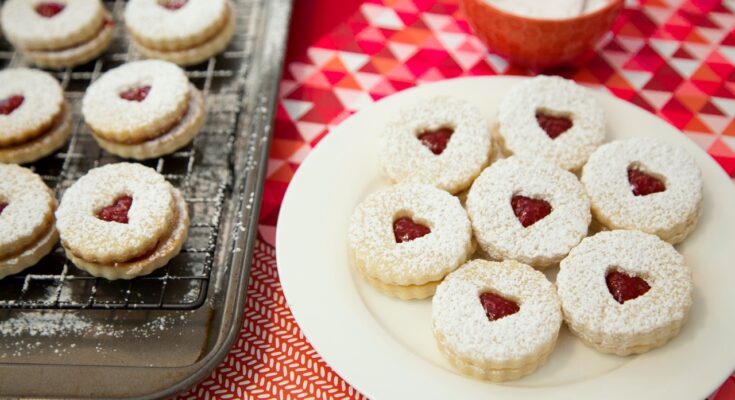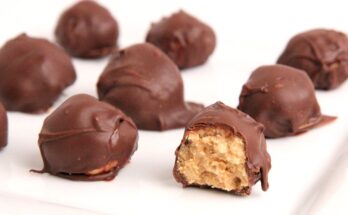Linzer Cookie Recipe: Linzer cookies are one of those delightful treats that bring both nostalgia and elegance to the table. What sets them apart from regular cookies is their beautiful sandwich-style design with a sweet jam filling peeking through a cutout in the top cookie. The combination of buttery almond dough and tart fruit preserves creates a perfect balance of textures and flavors that is both indulgent and comforting.
Typically, these cookies are dusted with powdered sugar, making them look like mini edible snowflakes – ideal for the holiday season but equally enjoyable year-round. They’re not just visually charming but also melt-in-your-mouth delicious. The dough is slightly crisp on the edges but tender in the center, creating a wonderful mouthfeel with each bite. Whether you’re baking them for a festive celebration or just because, Linzer cookies always manage to steal the spotlight.
Aside from their flavor and presentation, Linzer cookies stand out because they use almond flour or ground nuts as a base, adding a rich, nutty flavor that makes them taste a bit more sophisticated than your average sugar cookie. This unique combination of ingredients makes them a timeless European treat.
The Austrian Origin Story
Linzer cookies hail from Austria and are a derivative of the famous Linzer Torte – a traditional Austrian pastry that dates back to the 17th century. Named after the city of Linz, this dessert originally featured a buttery dough made with almonds, filled with red currant jam, and topped with a lattice crust.
The cookie version – Linzer Augen or “Linzer eyes” – is a simplified, hand-held rendition of this iconic pastry. These cookies retain the same foundational flavors: a nutty dough and a fruity filling, but are shaped into rounds with a center cutout to reveal the jam inside.
Over time, Linzer cookies have become a staple in European households, especially around Christmas. Today, they are beloved worldwide and are often associated with holiday cookie trays, tea-time snacks, and baking traditions passed down through generations.
Ingredients Needed for Linzer Cookies
Main Ingredients for the Dough
To make the perfect Linzer cookies, you’ll need high-quality ingredients. Here’s what you’ll want to gather:
- Unsalted butter (1 cup or 2 sticks, softened): This forms the rich base of the dough.
- Granulated sugar (½ cup): Adds sweetness.
- Egg yolks (2 large): Binds the dough and gives it richness.
- Vanilla extract (1 tsp): Adds depth of flavor.
- All-purpose flour (1 ½ cups): The primary dry ingredient.
- Almond flour or finely ground almonds (1 cup): Adds a nutty flavor and a tender texture.
- Salt (¼ tsp): Enhances the overall taste.
- Powdered sugar (for dusting): Gives that classic, snowy look.
It’s essential to use fresh, room-temperature butter for easy creaming and smooth incorporation. Almond flour is key to achieving that traditional Linzer cookie taste and texture – don’t skip it unless you’re making a nut-free variation.
Essential Ingredients for the Filling
The filling is the heart of any Linzer cookie. While raspberry jam is the traditional choice, feel free to experiment. Here’s what you can use:
- Raspberry jam (about ½ cup): Classic choice for tartness and vibrant color.
- Apricot preserves or strawberry jam: For different fruity flavors.
- Lemon curd or chocolate spread (optional): For a unique twist.
Make sure your jam isn’t too watery; a thicker consistency ensures the cookies won’t become soggy. If your jam is too runny, heat it slightly in a saucepan to thicken it before use.
Kitchen Tools You’ll Need
Baking Essentials for Perfect Linzer Cookies
A successful Linzer cookie recipe doesn’t require fancy gadgets, but having the right tools makes all the difference. Here’s what you’ll need:
- Mixing bowls: For combining your ingredients.
- Electric mixer or stand mixer: Helps in creaming butter and sugar efficiently.
- Measuring cups and spoons: Accuracy is key in baking.
- Rolling pin: For flattening the dough evenly.
- Round cookie cutters: You’ll need two sizes – one for the base, and a smaller one for the cutout on top.
- Baking sheets and parchment paper: For baking the cookies evenly without sticking.
- Cooling racks: So your cookies cool properly without getting soggy.
- Fine-mesh sieve: Perfect for dusting powdered sugar over the cookies.
These basic tools not only make the baking process smoother but also help ensure that your Linzer cookies come out looking professional and picture-perfect.
Step-by-Step Instructions
Step 1 – Preparing the Dough
The foundation of any great Linzer cookie is a smooth, flavorful dough. Start by creaming the softened unsalted butter and granulated sugar together in a large mixing bowl. Beat them until the mixture is light and fluffy—this usually takes about 2 to 3 minutes with an electric mixer on medium speed.
Next, add in the egg yolks one at a time, followed by the vanilla extract. Beat until everything is well incorporated. In a separate bowl, whisk together the all-purpose flour, almond flour, and salt. Gradually add the dry ingredients to the wet ingredients, mixing just until the dough comes together. Don’t overmix it, or your cookies may turn out tough.
Once the dough forms, divide it in half and shape each portion into a disk. Wrap the disks in plastic wrap and refrigerate them for at least 1 hour. Chilling the dough helps firm it up, making it easier to roll out and cut into precise shapes later. You can even leave the dough overnight if needed.
Step 2 – Rolling and Cutting the Cookies
Once your dough is properly chilled, it’s time to roll it out. Lightly flour your surface and rolling pin, then roll out one disk of dough to about 1/8 inch thickness. Keep the dough as even as possible to ensure consistent baking.
Use your larger round cookie cutter to cut out the base cookies. For the top cookies, use the same large cutter and then use a smaller cutter in the center to make the classic Linzer “window.” These are the ones that will showcase the jam filling.
Place the cookies on a parchment-lined baking sheet, spacing them about 1 inch apart. If the dough becomes too soft while you’re working with it, pop the tray into the fridge for about 10 minutes before baking.
This is also a great time to preheat your oven to 350°F (175°C), so it’s ready once your trays are full.
Step 3 – Baking to Perfection
Bake the cookies in the preheated oven for about 10–12 minutes, or until the edges are just turning golden. Be careful not to overbake—the cookies should be light in color with only the faintest browning on the edges.
Rotate the baking sheet halfway through to ensure even baking. Once done, remove the cookies from the oven and let them cool on the baking sheet for a few minutes before transferring them to a wire rack to cool completely.
The cookies need to be completely cool before assembly. If you stack or fill them while they’re warm, the jam might melt and make a mess, and the powdered sugar won’t sit nicely.
Step 4 – Adding the Filling and Assembling
Now comes the fun part—putting it all together! Start by spreading a small amount of jam (about ½ teaspoon) onto the flat side of each bottom cookie. Don’t use too much or it will ooze out the sides.
Then, gently press a top cookie (the one with the cut-out) over the jam, sandwiching them together. Press just enough to secure them, but not so much that the jam spills out.
Once all your cookies are assembled, use a fine-mesh sieve to dust powdered sugar over the tops. The sugar will give the cookies that beautiful snowy look, while also balancing the tartness of the jam.
Let the assembled cookies sit for at least an hour to allow the flavors to meld and the jam to slightly set. After that, they’re ready to serve—or store for later!
Tips for Perfect Linzer Cookies
Troubleshooting Common Issues
Even experienced bakers sometimes run into hiccups. Here are some common Linzer cookie problems and how to fix them:
- Dough too sticky to roll: This usually means it’s too warm. Pop it back into the fridge for 10–15 minutes.
- Cookies spreading too much during baking: Your dough might be too soft or warm. Chill the cut cookies on the baking tray before baking.
- Crumbly dough: If your dough is falling apart, it may need a bit more moisture. Add a teaspoon of milk or water and mix until it holds together better.
- Top cookies break while assembling: Handle them gently and make sure they’re fully cooled. You can also dust with sugar before assembling to avoid disturbing the jam.
Pro Tips for Texture and Flavor
Want to elevate your Linzer cookie game? Try these expert tips:
- Use high-quality butter and jam. These ingredients are the stars, so don’t skimp.
- Toast the almond flour slightly before adding. This brings out a deeper nutty flavor.
- Add lemon zest to the dough. A teaspoon of zest adds a fresh zing that pairs beautifully with raspberry jam.
- Use a piping bag for neat jam application. This helps control the amount and placement.
These small touches can turn your homemade Linzer cookies from great to bakery-worthy.
Variations and Flavor Twists
Nut-Free and Vegan Alternatives
Not everyone can enjoy traditional Linzer cookies due to dietary restrictions, but that doesn’t mean they have to miss out on the fun. Here’s how you can make nut-free and vegan versions that are just as delicious:
Nut-Free Option:
Instead of almond flour, use oat flour or simply replace the almond flour with an equal amount of all-purpose flour. While you’ll lose some of the nutty flavor, you’ll still get a buttery, crisp cookie. You can also try sunflower seed flour as a more flavorful substitute.
Vegan Linzer Cookies:
To go fully plant-based, replace the butter with a vegan butter alternative. Choose a brand that is designed for baking and has a similar fat content to real butter. For the egg yolks, use a flax egg (1 tbsp ground flaxseed + 2.5 tbsp water, mixed and set aside for 5 minutes) or a commercial egg replacer.
Use vegan jam or fruit preserves with no added gelatin, and check that your powdered sugar is organic or vegan-certified (some non-organic powdered sugars use bone char in processing).
Despite these swaps, you’ll still get beautiful cookies that taste amazing and hold their shape.
Creative Fillings Beyond Jam
Raspberry jam may be traditional, but there’s a whole world of fillings you can explore to put a unique twist on your Linzer cookies. Here are some flavorful ideas:
- Chocolate Hazelnut Spread (like Nutella): For a rich, indulgent treat.
- Lemon Curd: Adds a tart, citrusy burst that contrasts wonderfully with the sweet cookie.
- Peach or Apricot Preserves: These lighter jams offer a softer flavor profile.
- Blackberry or Blueberry Jam: For deep color and a sweet-tart punch.
- Dulce de Leche or Caramel: Decadent, especially when paired with spiced dough.
You can also flavor the dough itself with spices like cinnamon, nutmeg, or cardamom for seasonal flair. Want to go bold? Add a touch of chili powder to your chocolate filling for a spicy-sweet surprise.
Experimentation is key to discovering your signature Linzer cookie.
Storage and Shelf Life
Best Ways to Store Your Linzer Cookies
Linzer cookies are best enjoyed fresh, but they store surprisingly well if you follow a few simple rules. After assembling the cookies, let them rest for a few hours so the jam can slightly absorb into the cookie—this helps with flavor melding.
To store them:
- Room Temperature: Place the cookies in an airtight container, layered between parchment paper. They’ll keep for up to 5 days. Avoid humid environments as moisture can cause them to soften.
- Refrigerator: For longer freshness, store the cookies in the fridge. Let them sit at room temperature for 10–15 minutes before serving to bring back the texture.
- Freezer: You can freeze both the dough and the baked cookies (before filling). Stack baked cookies with parchment in between and seal in a freezer-safe bag or container. They can last up to 2 months this way.
If freezing assembled cookies, be aware the jam can change texture slightly. It’s usually better to freeze the parts separately and assemble after thawing.
Proper storage ensures your hard work lasts—and makes it easier to have homemade treats on hand for surprise guests or last-minute events.
FAQs about Linzer Cookie Recipe
Can I freeze Linzer cookie dough?
Yes! Linzer cookie dough freezes beautifully. Wrap it tightly in plastic wrap, then place in a ziplock bag. It will keep for up to 2 months. Thaw it in the fridge overnight before rolling it out.
What kind of jam works best?
Raspberry jam is traditional, but you can use any thick, high-quality jam or preserve. Look for ones without added water to avoid soggy cookies.
Why are my cookies too soft?
If your cookies are too soft, they may have been underbaked or stored in a humid area. Try baking them a minute longer and let them cool completely before assembling.
How long do Linzer cookies stay fresh?
They stay fresh for 4–5 days at room temperature in an airtight container. For longer storage, refrigerate or freeze them.
Can I make Linzer cookies gluten-free?
Absolutely. Use a gluten-free flour blend in place of the all-purpose flour. Make sure it’s one that’s designed for baking to ensure the right texture.
Conclusion
Linzer cookies aren’t just another sweet treat—they’re a celebration of tradition, flavor, and craftsmanship. From their nutty, buttery base to the vibrant jam center and snowy sugar dusting, every bite is a perfect mix of texture and taste. Whether you stick with the classic raspberry filling or venture into creative territory with lemon curd or chocolate, making Linzer cookies from scratch is a rewarding experience.
And it’s not just about taste—baking these cookies is a festive ritual. Rolling, cutting, assembling—each step brings joy and anticipation, especially when shared with family or friends. These cookies aren’t just desserts; they’re edible memories.
So next time you’re craving something special, skip the store-bought sweets and treat yourself to a homemade Linzer cookie. Trust me—once you take that first bite, you’ll be hooked.



